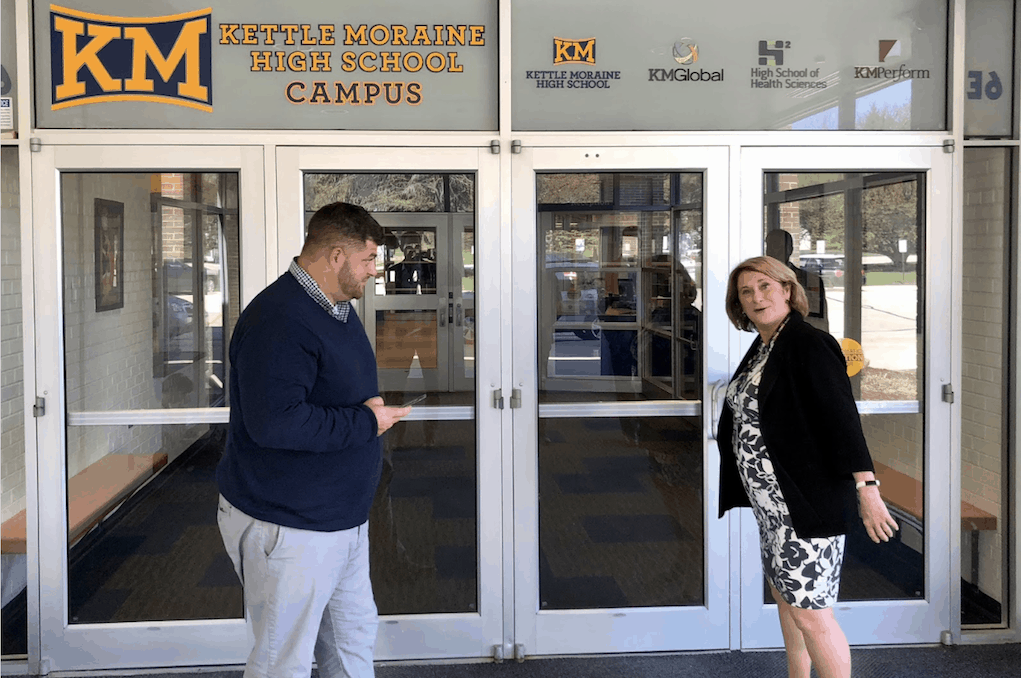Empower Learners: 10 Lessons on Innovation Leadership

Thirty miles west of downtown Milwaukee, a suburban community is well served by the Kettle Moraine (KM) School District (@kmdistrict). Even a quick encounter with Superintendent Patricia DeKlotz and her capable team will make evident 10 leadership lessons relevant for any organization.
1.Get clear about outcomes that matter–and track progress. The KM graduate profile has six dimensions: continuous learner, communicator, collaborator, creative and critical thinker, engaged citizen and self-directed and resilient individual. Learner progressions indicate where students are and define next steps. Learning resources are available online anytime anywhere.
2. Leadership by walking around. Drawing from the hospital practice of rounds, the administrative team walks and talks with staff and students. DeKlotz emphasized, “I want the communication. I want to know people’s names and what they are thinking about.” The visibility and accessibility builds culture and relationships. It also sets the stage for critical conversations about beliefs, skills and actions; and conversations about when expectations weren’t being met.
3. Structures for strategic conversations. Every few years the district engages 100 members of the community in building a strategic vision. Every year the school board and leadership council, consisting of 24 community members and educators, reflect on performance, feedback and the future. This annual retreat builds trust, accountability and goal clarity. Schools use the same process to update their own plans.
4. Personalized learning for all. Outcome clarity and lots of formal and informal conversations have created a shared picture of their core process– powerful learning experiences. The commitment to all learners creates strategic tension as innovations are piloted and the question turns to how and when they will be integrated so more students gain access.
5. Fast lane, slow lane change leadership. DeKlotz identifies and supports change leaders, allowing them to move fast. They created four charter schools inside existing schools to pilot innovations. But like students, she knows her staff is not all ready and equipped to move at the same speed. While they want the best for every learner, they also recognize that staff (like students) progress at different rates and require different supports.
6. Build competency-based talent development pathways. Kettle Moraine is moving away from time based courses to competency-based progressions for staff and students. Teachers choose from personalized, proficiency-based micro-credentials (as DeKlotz describes in this podcast).
Assistant Superintendent Theresa Ewald described how they are building competency-based high school skill and career pathways, “Pathways developed around a progression of skills (English, math, music, Spanish) allow learners to demonstrate their entry level of skills/understandings through a pre-assessment system. Once a level of competency is demonstrated a learner knows his/her starting point. They can then begin to work on demonstrating competencies to show how they are progressing. Learners are not bound by time or limited by the schedule.”
Steve Plum, who leads The High School of Health Sciences, explained that all 9th graders take physics but some may complete in six month, others may take 18 months.
In career pathways like computer science, learners can select competencies for web design or C++ or Java and many more. Once they have demonstrated, through artifacts and evidence, the competency in their declared area they earn .5 credit and can then select another set.
7. Invest in leaders. Structured as small schools and learning environments, the district offers many leadership opportunities for teachers. DeKlotz and Ewald meet with principals frequently for dialogue, reflection, and problem-solving. They host conferences where emerging KM leaders share what they are learning.
8. Support strategy with flexible inspiring space. As the district’s learning agenda has evolved, so have the facilities. Over time, the large traditional high school has been transformed into flexible learning environments with a variety of settings, collaboration spaces, and maker facilities.

9. Culture. The culture of the schools vary to some degree but all emphasize belonging, safety, and risk-taking as part of building growth mindsets, collaboration and value feedback loops that enable continuous improvement.
10. Empower learners. The idea of delighting your customers, finding ways to exceed expectations, has been around for a couple decades. At Kettle Moraine, DeKlotz said they want “to empower learners so they want to spend their day here figuring out who they are.”
Steve Plum said that students could have as many as ten community-connected learning experiences. And in some cases an internship confirms career interests, in other cases, students realize it’s not what they want to do.
Kevin Erickson, Director of KM Perform, an arts-focused school, explained that only about 20% of his graduates pursue careers in the arts but all of them appreciate the arts integration.
“The Agency that comes from these new schools is much different than compliance-based environments,” explained DeKlotz. “Kids leave with direction, realizing who they are, what they want to experience on their personal journey.”
It’s obvious even on a short visit that Kettle Moraine has created environments where young people love to be. It’s a place that empowers learners–young and old.
Kettle Moraine is a leader in personalized learning and emerging as a leader in competency-based and community connected career learning. Perhaps most importantly, it’s a model for innovation leadership and an inspiring example for any organization.
Thanks to Chris Sturgis for her 10 part series on Kettle Moraine which provided useful details for sector leaders and this article.
For more see:
- Transforming High Schools: 8 Strategies for EdLeaders
- 100+ Middle and High Schools Worth Visiting
- Getting Smart Podcast | Kettle Moraine’s Pat DeKlotz on Building a Culture of Innovation
This post was originally published on Forbes.
Stay in-the-know with all things EdTech and innovations in learning by signing up to receive the weekly Smart Update.





0 Comments
Leave a Comment
Your email address will not be published. All fields are required.